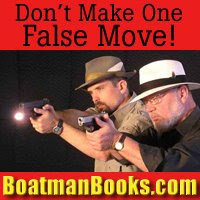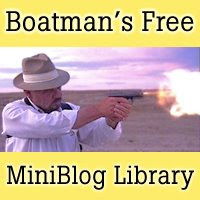An octogenarian riflemaker who’s got a 10-year backlog of custom orders on the books doesn’t need a neon sign out front inviting people off the street to walk in and take a seat.
So even on my first visit to the legendary artist it was no big surprise when I found out that the street address of Fred Wells' workshop in downtown Prescott, Arizona doesn't actually exist.
The kind lady at the corner grocery store didn’t even try to explain to me how to find Fred, she took me by the hand and led me down the sidewalk a ways, suddenly turned into a narrow covered passageway between two buildings, and guided me down the dark tunnel to near the walled-up end where there was a choice of walking through a screen-door into the kitchen of a neighborhood diner or through a solidly closed and unmarked door directly across from it. There she left me to my own devices, assuming I would make the right choice.
I didn’t. The closed door led me to Fred’s workshop, but Fred was next door in the diner having lunch. As it turned out, I was too mind-boggled at what I had just walked into to even note Fred’s absence, and when he did arrive it took me a few seconds to come out of my daze long enough to shake his hand.
“I’ve been here on this block for 55 years,” Wells said. “How long have I been in the gun business? Well, I’m in my eighties and I started repairing rifle stocks when I was 12. You figure it.” A brief glance around the place tells you immediately that Fred Wells progressed way beyond the stock repair business a long time ago.
“We do everything in here. Rifles and shotguns of every description. We even make a lot of our own pistols. We’re not prima donnas. Every once in a while we even do a little horsetrading.”
Though Fred will happily restore or replace a fore-end or pistol grip cracked from the recoil of a big African cartridge meeting a hidden imperfection in straight-grained walnut, what he’s been most celebrated for over the last several decades is building custom rifles from the ground up, quite literally lock, stock and barrel. Given this master gunsmith’s predilections, that usually means transforming a few raw chunks of steel and wood into a hand-made Mauser-type turnbolt action perfectly mated with an exhibition-grade walnut stock in the “cap-action” manner where the metal covers the flat edges of the wood so there are no raw edges and no screws exposed anywhere, a big-bore barrel chambered for a powerful cartridge of his own design with the precisely correct rate of twist for heavy dangerous-game bullets, and full engraving in the Old World style as a finishing touch. The end result is a classic African gun with impeccable fit, finish, balance and performance.
The rifle he built for the Baron of Bavaria to present as a royal gift to the King of Sweden is such a gun, and so are many of the others hanging on the walls, leaning up in corners, cradled in trophy moose racks, lying across a workbench, suspended from the ceiling, tucked away behind curtains and otherwise occupying less grand spaces than they deserve all over the place in the cluttered old museum storeroom Fred calls a shop. There is little that is not fit for a king here, but the precious objects are just old friends and relatives to the man who’s responsible for their existence.
Second only to the turnbolt actions he builds himself, Wells strongly prefers to work with pristine examples of the commercial Mauser ’98, though he has also worked wonders with beat-up old military actions from every country in the world that has ever relied on Mauser rifles which is virtually every country in the world. If you have a pair of eyes, he doesn’t have to tell you this. One very long wall is filled two tiers deep with top-grade examples of every sporting Mauser model in every caliber ever made. Mauser historians come over from Germany just to stare at that wall in awe. But foreign dignitaries are the least important of the characters who have considered Fred’s old place an inspirational hangout.
“Jack O’Connor and I never went hunting together, but I built a lot of guns for him and he and I spent a lot of time just like you and I sitting here jawing. I built him a .458 to take to Africa and he said, ‘Don’t you tell anybody you built me a big old .458.’ Jack was quite a guy, great big booming voice and very opinionated. This was in the ‘50s, when Jack was both a journalist and a professor at Tucson.
“I first met Elmer Keith in Missoula, Montana in 1938. He did love the big bores, but I built him a little 35-caliber rifle he liked more than he told anybody. Elmer was always entertaining.
“I remember at one big gun show, Jack O’Connor and I were standing there when Elmer Keith came down the aisle. Jack looked up and said, ‘Here comes Mr. Bullshit.’ He stepped out there and he hollered, ‘Draw!’ Elmer came up and said, ‘You big sonofabitch, you’re gonna get somebody shot doing that someday.’
“Of course, Keith’s reputation was built on throwing cannons and O’Connor’s on stretching the .270, but their feud was really a put-up job for the press.
“Charles Askins used to come in, and Bill Ruger was in all the time. Ruger built that big factory just outside town where they make pistols and golf clubs, but I think Bill spent more time in here than out there.”
Fred Wells is spry and lively with a mind as sharp as a tack, as are many men in their eighties who’ve lived particularly adventurous and creative lives. Other than indulging in an occasional whiff of oxygen (Prescott is 5,354 feet up in the foothills – that’s mountains to you easterners) Fred doesn’t seem to be burdened by his eight decades of experience. He’s quite aware of the latest developments in firearms technology, but he’s not adverse to a little reminiscing about the good old days either.
“When I was younger I couldn’t afford to buy the guns I wanted, so I built them myself. That’s what really got me started. When I got old enough to make enough money I did buy a Model 70 Winchester, and I got to looking at it and said, I can do better than this. Then I got pretty well acquainted with the Mauser system and it’s so superior to any of the rest of them.
“My biggest headache is I fall in love with these things when I build ‘em, kind of hate to see ‘em go out the door. But you’re happy that the man who gets the gun is happy. It’s nice to be able to make a comfortable living doing what you like to do. I always said If I had a lot of money I’d build guns and just give them to people I like.”
Don’t get your hopes up. I mentioned the rather lengthy backlog Fred is currently working on, and don’t think that if he likes you he’ll bump you up a few years. He likes everybody on the list. He doesn’t build rifles for people he doesn’t like.
Caressing the gold inlaid Cape Buffalo engraved on the receiver of a.416 Rigby, Fred says, “Most of my customers love the big stuff, and I’ve always loved the big stuff too. For years a lot of American riflemakers wouldn’t build big guns like this. One of my customers came in here and said, ‘What I like about you, Wells, is you never say no. You cost me money but you never say no.’”
Fred showed me a series of photos of a big fellow shooting a 4-bore rifle loaded to the hilt, so to speak. The recoil lifted the big gun straight up over the man’s shoulders pointing to the sky, spun him around 180 degrees and shoved him face-down in the dirt. But he held on to the rifle and didn’t drop it. Another couple of photos showed another, bigger man firing an 8-bore double, with the rifle landing about fifteen feet away from him.
“Big guns are fun,” Fred said.
He showed me some preliminary sketches of an action type few people on the planet have ever seen before. “I had a fellow wanted me to build a double-barreled bolt-action rifle. Literally two Mauser type actions built into one gun side by side with a set of gears so you could operate both actions independently with the bolt. The receiver had to be titanium to hold the weight down.
“It’s surprising the number of African hunters we have here in Prescott, but then everybody wants to own a big-bore rifle whether they ever use it or not. They can fondle it and dream they’re going to Africa. When wildlife shows come on they can shoot the TV. You’d be surprised how many TV sets are shot out around here.”
As Fred talks about his love for big-bore African rifles, resting behind him on a table is his custom-built action for a 700 Nitro Express, a monster nobody on earth builds but Holland & Holland and Fred Wells. Behind it, awaiting only the most subtle of finishing touches, is a deluxe rifle chambered for the monstrous .50 BMG. It looks like another fine Wells-built African bolt-action rifle, but one that has seriously overdosed on steroids. Fred’s assistant, Jim Coffey, looks at this massive gun with particular pride, as Jim was in on the design and construction of it and has a particular affection for building and shooting the most powerful shoulder-fired weapon you can get.
“A fellow at a gun show stood seven-foot-four and weighed 400 pounds,” Fred says. “He picked this up and put it to his shoulder and said, ‘Somebody’s finally built a rifle just for me.’”
Big guns require big cartridges and Fred has developed his own hot-rod versions of the classical African line-up. He shows me samples of the wildcat Wells Express in .585, .510, .458, .416 and .375, all built on the .577 Nitro rimless case. He also stirs up a mean-spirited .350 Wells Express on the .378 Weatherby case.
Besides Jim Coffey’s gunsmithing help, Fred relies on Mark Swanson for much of the metal engraving work. Mark is an accomplished Western painter in his own right, and studied rifle engraving under the master who is primarily responsible for that operation in Fred’s shop. That master engraver is Rachel Wells, Fred’s wife of 47 years.
“Once Rachel got the kids raised she decided she wanted to help out in the shop. One day a boy came in with an engraving machine he didn’t know what to do with and she bought it. Not one engraver would tell her a thing about the art. What a tight-knit bunch they are. She had to trade the services of her German Shorthair bitch to one engraver’s birddog before he would even tell her how to sharpen her tools. She had a natural talent though, and she was doing world-class work in practically no time. She learned most all of it herself, and she said if anybody ever wanted to know anything about engraving she would teach them. She’s been teaching engraving at Yavapai College now for 18 years.”
Fred Wells was born in Indiana, spent a short time in Montana and California, and moved to Arizona at the ripe old age of six. He’s hunted all over North America, which accounts for a lot of the trophies on the wall. His son likes to hunt Alaska, which accounts for a lot more. And his grandson has hunted Africa many times, which accounts for the rest.
None of this trophy game was shot with ordinary hardware either. Wells rifles – hand-built, engraved from butt-plate to barrel-crown, chambered in a cartridge designed specifically to bring down any particular species you might be looking for, worth the price of a race car – are meant to be used in the field of the hunt.
“The Prince of Bavaria used to come down to Prescott all the time to hunt. He used my rifles, and he wasn’t the only prince on the mountain using them.”
I asked Fred what he had left that he wanted to do. “I always wanted to make a working museum,” he said. “Where you could come in and stand behind glass panels and see everything that goes on in the riflemaking business. A wife could leave her husband for half an hour while she went shopping and come back two hours later and try to pry him out of here. I almost got the Catholic Services Center across the street at one time. That would be a good museum location.”
As I was leaving what I thought was already one of the best museums I’ve ever visited, even without glass panels, I noticed an old sign that read Wells Sport Store, evidence that at one time Fred Wells actually advertised for more business. Suspended near it was an exotic looking automobile chassis, somehow not at all out of place in this den of ageless male passions.
Fred looked up at it and said, “In my spare time I build sports cars. I copied that from my 300 SL gull-wing.”
I bet he improved on it too.
Fred Wells is dead.
When Jeff Cooper wrote of the sudden passing of Fred Wells in the May ’06 issue of Guns & Ammo magazine, he said, “Few people make any difference, but Fred has left his mark. He will not be forgotten.” Similar words would, of course, be written about Jeff Cooper a few months later.
skip to main |
skip to sidebar
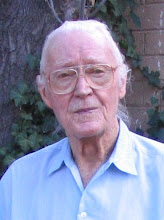
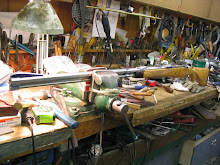
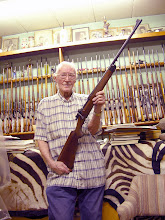


Fred Wells’ Old Place: Hallowed Ground
Fred is not with us anymore. But he will not be forgotten.
Fred has left his mark

fred's desk
Fred with the latest Wells rifle

sign dates from the days when fred needed to advertise for business

hand-made wells mauser action for a .50 BMG in progress



